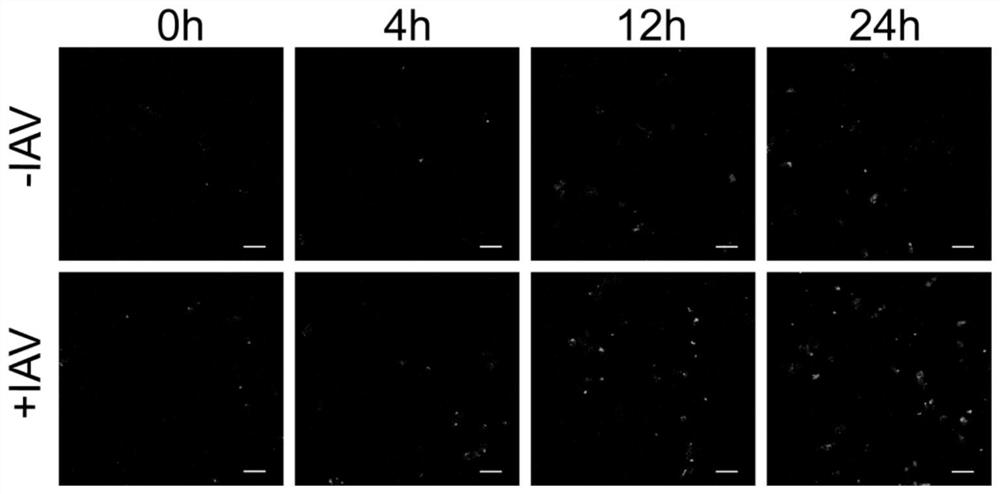Influenza A virus nucleic acid labeling method based on rare earth up-conversion nanoprobe
An influenza A virus and rare earth up-conversion technology, which is applied in the fields of biotechnology and materials, can solve the problems of difficult real-time fluorescence monitoring for a long time, poor photostability, and wide emission spectrum of organic fluorescent dyes, and achieves the effect of high scientific research application prospects.
- Summary
- Abstract
- Description
- Claims
- Application Information
AI Technical Summary
Problems solved by technology
Method used
Image
Examples
Embodiment 1
[0026] Take the surface carboxylated rare earth up-conversion nanoparticle solution, add EDC (1-(3-dimethylaminopropyl)-3-ethylcarbodiimide hydrochloride) and NHS (N-hydroxyl succinimide) was activated by rotating overnight, centrifuged, discarded the supernatant, and added ddH 2 O resuspended with streptavidin:ddH 2 O volume ratio is 1:1000, add streptavidin, rotate and mix well, centrifuge and add ddH 2 O resuspended to obtain streptavidinized rare earth up-converting nanoparticles; the volume ratio of stem-loop solution: streptavidinized rare earth upconverting nanoparticles solution was 1:100 to streptavidinized rare earth upconverting nanoparticles The stem-loop DNA is added to the solution of the rare earth upconversion nanoparticle, and the rare earth upconversion nanoprobe for labeling the viral nucleic acid is obtained after the rotation reaction. After labeling influenza A virus nucleic acid with rare-earth up-conversion nanoprobes in the cells, add mouse anti-HA a...
Embodiment 2
[0028] Take the surface carboxylated rare earth up-conversion nanoparticle solution, add EDC (1-(3-dimethylaminopropyl)-3-ethylcarbodiimide hydrochloride) and NHS (N-hydroxyl succinimide) was activated by rotating overnight, centrifuged, discarded the supernatant, and added ddH 2 O resuspended with streptavidin:ddH 2 Add streptavidin at a volume ratio of 1:500, rotate and mix well, then centrifuge and add ddH 2 O resuspended to obtain streptavidinized rare earth up-converting nanoparticles; the volume ratio of stem-loop solution: streptavidinized rare earth upconverting nanoparticles solution was 1:100 to streptavidinized rare earth upconverting nanoparticles The stem-loop DNA is added to the solution of the rare earth upconversion nanoparticle, and the rare earth upconversion nanoprobe for labeling viral nucleic acid is obtained after the rotation reaction. After labeling influenza A virus nucleic acid with rare-earth up-conversion nanoprobes in the cells, add mouse anti-HA...
Embodiment 3
[0030] Take the surface carboxylated rare earth up-conversion nanoparticle solution, add EDC (1-(3-dimethylaminopropyl)-3-ethylcarbodiimide hydrochloride) and NHS (N-hydroxyl succinimide) was activated by rotating overnight, centrifuged, and the supernatant was discarded, and ddH was added 2 O resuspended with streptavidin:ddH 2The O volume ratio is 1:200, add streptavidin, rotate and mix, centrifuge and add ddH 2 O resuspended to obtain streptavidinized rare earth up-converting nanoparticles; the volume ratio of stem-loop solution: streptavidinized rare earth upconverting nanoparticles solution was 1:100 to streptavidinized rare earth upconverting nanoparticles The stem-loop DNA is added to the solution of the rare earth upconversion nanoparticle, and the rare earth upconversion nanoprobe for labeling the viral nucleic acid is obtained after the rotation reaction. After labeling influenza A virus nucleic acid with rare-earth up-conversion nanoprobes in the cells, add mouse ...
PUM
 Login to View More
Login to View More Abstract
Description
Claims
Application Information
 Login to View More
Login to View More - R&D Engineer
- R&D Manager
- IP Professional
- Industry Leading Data Capabilities
- Powerful AI technology
- Patent DNA Extraction
Browse by: Latest US Patents, China's latest patents, Technical Efficacy Thesaurus, Application Domain, Technology Topic, Popular Technical Reports.
© 2024 PatSnap. All rights reserved.Legal|Privacy policy|Modern Slavery Act Transparency Statement|Sitemap|About US| Contact US: help@patsnap.com









